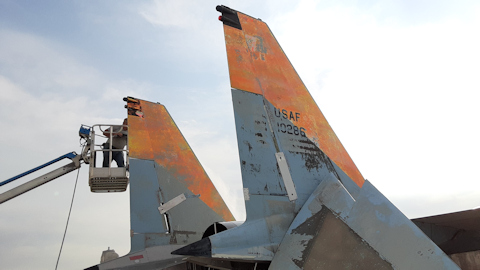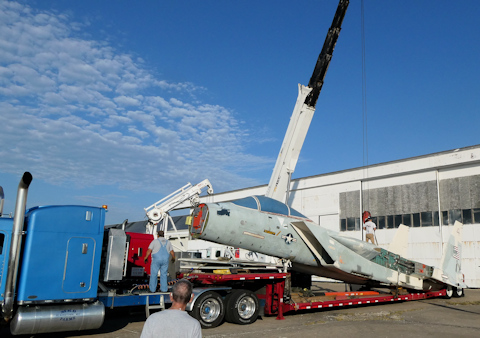 |
||||||||||||||||||||||||||||||||||||
TOPEKA REGIONAL AIRPORT @ FORBES
FIELD, TOPEKA, KANSAS |
||||||||||||||||||||||||||||||||||||
 |
||||||||||||||||||||||||||||||||||||
 |
||||||||||||||||||||||||||||||||||||
Siemens-Schukert D1 7/8ths Scale Replica German WWI Fighter(N921SS) |
||||||||||||||||||||||||||||||||||||
On July 1, 1969 three F-15 airframe competitors, Fairchild, North American and McDonnell Douglas, submitted technical proposals to a Source Selection Evaluation Board (SSEB) of the U.S. Air Force to meet the service's need for a dedicated air superiority fighter. The mission of the F-15, as stipulated by the Air Force, was to be an all-weather, extremely maneuverable, tactical fighter designed to permit the USAF to gain and maintain air supremacy over the battlefield. In Dec 1969 McDonnell Douglas was selected, from the three competitors, to move forward with the design and an initial contract for 20 test development and operational evaluation aircraft. In Feb 1970 the F100 engine contract was awarded to Pratt & Whitney and by October of that same year Hughes was awarded the attack radar contract. One of the more unusual aspects of the F-15 developmental program was the construction and use of large 3/8-scale glider models of the F-15 concept which were dropped from an NASA-operated Boeing NB-52B (52-0008) at the NASA Dryden Flight Research Center, Edward Air Force Base (AFB) in California. The models were made of aluminum, wood, and fiberglass. They weighed 2,425 lbs each and were 23.8 feet long with 16-foot wingspans. During the drops from the B-52 at 45,000 feet and 175 knots, the models were under radio control from the ground, and were directed through high angle of attack, stalling, and spinning maneuvers. At the end of the flights, the models deployed a parachute and were recovered in midair by a helicopter. (credit:Joe Baugher Mlitary Aircraft Serial Numbers) The first F-15 (71-0280) made its ceremonial debut on Jun 26, 1972 at the McDonnell Douglas facility in St Louis, MO. Painted in the new "Air Superiority Blue" color and christened the 'Eagle', it was hailed as America's first specifically designed superior tactical fighter since the F-86 Sabre appeared some 20 years earlier. '280' was stripped down and shipped to Edwards AFB, in a C-5A, where it was reassembled and made its first flight on July 27, 1972. Flight testing of the 20 evaluation aircraft took place at three locations - Edwards AFB, Eglin AFB and the McDonnel Douglas airfield in St. Louis. The testing at Edwards AFB was under the direction of the F-15 Joint Test Force (JTF). "Air Superiority Blue" painted test aircraft were difficult to see in flight and, as no one wanted a mid-air collision, large portions of the outer wings and the vertical tails of each test aircraft were painted a day-glo orange. The F-15A airframe (71-0286), on display at the Combat Air Museum, was the seventh production model (MSN 0007/A007) off the McDonnell production line and it was flown to Edwards AFB on June 14, 1973 where it joined the evaluation aircraft undergoing combined USAF and McDonnell flight testing. '286' was used as the trials aircraft for armament development - to ensure Raytheon AIM-7F Sparrow missiles and Philco-Ford AIM-9E Sidewinder missiles could be safely launched throughout the flight envelope. In addition, the vibration and aerodynamic air loads imparted by the F-15 airframe onto the missiles, were measured using special instrumented captive missiles. Before this airframe's flight testing was scheduled to begin on July 23, 1973, extensive wind tunnel testing data was collected and a "safe separation" digital computer modeling program was created to predict the behavior of the missiles when they were launched throughout the F-15's large flight envelope. The F-15 was not only the first US fighter to exclusively use the AIM-7F "Advanced Sparrow" but was also the first fighter to mount the Sparrow missiles on the "corners" of the fuselage. During actual flight testing "Clearing the Envelope", as the procedure was called, was a high risk proposition. In similar testing on June 20, 1973, the Navy's new F-14A 'Tomcat', also undergoing testing and evaluation trials with a dummy AIM-7E-2 Sparrow missile, shot itself down while clearing the envelope. Due to the high-risk nature of missile launch testing, '286' was not assigned to any other component evaluation as it was highly possible that the aircraft could be lost during the conduct of the missile test flights. '286' was fitted with a minimum of systems in case the aircraft was destroyed. The radar was replaced by lead ballast and a metal flight test radome with a flight test boom was installed. A special flight test data collection and telemetry system was also installed. High speed cameras were mounted under the wing tips and fuselage to capture the launch. Most test flights were filmed by accompanying USAF F-4E or T-38 photo/safety chase aircraft. On Nov 13, 1973 '286' had a minor mishap while "Clearing the Envelope". The logbook report reads "The inert missile struck the aircraft's left wing in the area of the Tactical Electronic Warfare System (TEWS) antenna and clearance light. At launch hook release wing #1 rolls into the aircraft fuselage. During the ejection stroke the wing tip (W1) drags down the fuselage. At the end of the stroke, as soon as the missile is free from the 180 degree fwd foot, the missile nose starts to rise up and out (toward the left wing tip). About 5 inches after the end of the stroke the missile does a 20 degree CW roll and then reverses at a high rate to the wing #1 up position. During this time the missile nose is still pitching up. At the time of the impact the missile is approx. 70 degrees nose up and fin #5 strikes the wing tip breaking fin #5 off. The missile starts to tumble end over end." (see image below of the wing tip damage). Major accomplishments of the F-15 test program at Edwards AFB were as follows: '286', during the entire phase of Joint Force Testing, racked up 92 flights with 77.7 flight hours and was part of the testing from July 1973 until Nov 1980. It was then withdrawn from testing and redesignated as GF-15A. Thereafter it was repurposed as GIA (Ground Isolation Assault) at the Technical Training Center, Chanute Air Force Base at Rantoul, IL from March 1982 to Aug 1990. This aircraft was finally withdrawn from service and placed on display at the Octave Chanute Aerospace Museum, Rantoul, IL from April 1994. The Canute Aerospace Museum shut its doors at the end of 2015 and the aircraft was dismantled and stored offsite at the St. Louis Science Center storage facility in Perryville, MO until July 2022. On July 20th, 2022 the airframe and component parts (wings, droptanks and other external parts) were transported to the Combat Air Museum in Topeka Kansas by Worldwide Aircraft Recovery out of Springfield MO. This aircraft is on loan from the National Museum of the United States Air Force, Dayton, Ohio.
|
||||||||||||||||||||||||||||||||||||
| |






